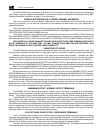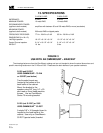
S-125/S-125C/S-85/S-85C page 6
If you have a separate electronic high-pass filter (such as the M&K VF-80 or HP-80), always use the WIDE RANGE
terminals, as you do not want to have this combination of dual filters operating. This also applies if your amplifier or
controller has built-in high-pass filters (such as THX-approved components and AC-3 units).
4. S-125C & S-85C CENTER CHANNEL USAGE
Because the S-125C and S-85C center channel speakers are designed to match their left and right channel
counterparts, the instructions in section 3 apply identically to both speaker versions. These center channel speakers
are designed to be oriented horizontally and located above or below your television screen. The front baffle of these
speakers is angled so that its sound can be focused towards your ears when you are seated in the main listening
position. When the speaker sits on top of a television set, place it so that it aims down. When it is underneath or below
the screen, place it so that it aims up. For a more discussion of center channel speaker placement, see page 8.
CAUTION: If you are feeding your subwoofer with speaker wires from your amplifier's left and right channels (not
with an RCA - RCA cable from the processor's SUBWOOFER OUTPUT), you MUST set the processor's center channel
switch to the NORMAL position. If you do not, the center channel bass will not be fed to the subwoofer. You should
still use the LOW CUT (HIGH PASS FILTER) terminal, as the combination of both filters will be about 12 dB/octave.
5. OPTIMIZING SPEAKER PLACEMENT
The sound quality produced by your speakers can be significantly enhanced by careful attention to their
placement. While we understand that you may not redesign your room to accommodate your speakers, coming as
close as possible to the ideal placement will give you much better sound.
The left and right channel speakers can be oriented either horizontally or vertically (if you have the S-125s, the
preferred orientation is vertical, but horizontal orientation is acceptable. When oriented vertically, the angle on the front
baffle should point towards the center of the room, not to the side walls (see Figure 2 on page 7). When oriented
horizontally, the angle on the front baffle should point down if the speaker will be above your head when you are listening,
and up if the speaker will be below your head. The Center channel speaker is designed for horizontal orientation
(tweeter and woofer drivers next to each other), and should be angled towards your listening position.
Three factors are important in getting the best sound. They are:
A. Height (or angle).
B. Location away from room walls or reflecting surfaces.
C. Separation between Left and Right speakers.
A. HEIGHT (OR ANGLE)
Your M&K Satellites will always deliver sound superior to conventional speakers, regardless of where you locate
them. However, because they are designed for very fast and accurate transient response, they achieve even better
sound quality, and the flattest frequency response when properly oriented relative to your ear.
Ideally, the tweeters should be at the same height from the floor as your ears, when you are sitting in your main
listening position.
If you have the speakers mounted above or below this height, we recommend that you angle the speakers so that
the tweeters are aimed at your ears when you are in the main listening position.
If you have a helper move the speakers while you sit and listen, you should be able to hear the difference when
the speakers are in the best location by listening for the brightest high frequencies and for the best "focus" of sound,
where you hear the sharpest sonic imaging of voices and instruments.
B. LOCATION AWAY FROM REFLECTING SURFACES
Your Satellites should be located, whenever practical, away from walls, the floor, furniture, or any other reflecting
surfaces. Do the best you can. Objects close to the speaker will reflect sound, and this reflected sound arrives at your
ear slightly later than the direct sound, which blurs sonic imaging and makes transients seem muted.
The delay is very slight, so instead of hearing an echo, you hear a "blurred" sound with less clarity that is not as
sharp and distinct as it should be. This time delay also affects frequency response and sonic imaging.














